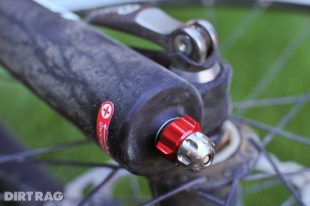First Ride: SR Suntour Revamps the Durolux
Originally posted on September 2, 2015 at 0:01 amBack in July, SR Suntour invited us to Mountain Creek Bike Park to check out new-for-2016 front and rear suspension products. Although SR Suntour may be best know to some readers as a the suspension brand most often spec’d on trekking and budget mountain bikes, the company has been working incredibly hard in recent years to improve performance though technological advancement, while maintaining the price point and serviceability that are key tenants of the company’s philosophy.
In order to make all this happen, SR Suntour brought on French suspension engineer Stephane Guillaume. Guillaume put in extensive time with Marzocchi during its hayday, so he knows a thing or two about suspension.
The New Durolux

SR Suntour’s burly Durolux has undergone a complete overhaul for 2016. For starters, the new design targets 27.5-inch wheels, while the existing Durolux will continue to serve the 26-inch wheel market. Stanchions are up from 35 mm to 36 mm. Obviously, that change requires all-new magnesium lowers, which offer excellent fit and finish. Wisely, SR Suntour incorporated threaded fender mounts on the Durolux lowers and forks will ship with a fender. Lubrication holes allow owners to splash a few drops of oil on the foam wipers periodically to keep things moving freely. Travel is internally adjustable between 160, 170 and 180 mm settings.


The big story in forkland is the all-new closed-cartridge R2C2 damper that will sit above the existing RC2 damper in the lineup. Yep, you guessed it. Independent high- and low-speed rebound circuits, in addition to independent high- and low-speed compression damping. All circuits are damped via shim stack and externally adjustable.

Instead of using a bladder system like Fox and RockShox, SR Suntour utilizes a spring-loaded piston compensator at the top of its new closed-cartridge damper. By employing a very soft (1 N m) spring, the piston is able to accommodate oil displaced by the damper with a minimal increase in seal friction. Not only is this system simple, but it’s said to be easier to bleed than a bladder system as it doesn’t require the use of syringes. This design is similar in concept to the floating piston used in rear shocks, but does not require a high-pressure nitrogen charge, making it far easier to service.
At the launch, Guillaume talked a lot about the cause and implication of cavitation on suspension systems. Cavitation is the vaporization of a liquid at low pressures. This oil vaporization occurs on the low-pressure side of the piston during compression and rebound above shaft speeds of approximately 4 m/s.
Incredibly, mountain biking causes some of the fastest shaft speeds of any suspension system due to the speed of the rider, intensity of the terrain and, most importantly, the low un-sprung weight of our components. The heavier mass of automotive and motorcycle wheel and suspension systems make them far slower to reaction to bump force. Automotive applications top out around 2 m/s of shaft speed, while motocross bikes top out around 6 m/s. A World Cup downhiller, however, is capable of regularly punishing a fork with over 9 m/s of shaft speed throughout a run.
Over time, or over the course of a long run under a pro, this cavitation ends up causing air bubbles to form inside the damper as the oil heats up and degrades. Once air bubbles have formed, only bleeding will remove them. Given the inevitability of needing to bleed the system, Guillaume developed a quick and easy bleed system for the R2C2 damper in order to fulfill the company’s Quick Service Product (QSP) philosophy. Just fill the damper with oil, place the floating piston in the cartridge with the bleed screw removed, cycle the damper to remove air, push the damper rod to end of stroke and reinstall the bleed screw.
SR Suntour continues to utilize an air positive spring and coil negative spring arrangement, but the positive are volume is now adjustable via a series of spacers. Lighter and firmer negative springs are available directly through SR Suntour for lighter and heavier riders.

One carryover item is the slick Q-LOC2 thru axle in 20 mm diameter. According to Suntour, folks shopping in the 160-180 mm market served by the Durolux gravitate to the larger standard. The new Durolux tips the scale at 5.16 lbs.
On the Trail

The early-production samples we rode at Mountain Creek were impressive. The air volume spacers provide progressive ramp-up for aggressive riders like Mike Hopkins and a bit plusher and less progressive ride for those of us who aren’t pro.
The R2C2 damper provides a wide range of adjustment, of which I found myself on the lighter end of the spectrum. There’s plenty of damping available for hard-chargers. The high- and low-speed rebound adjustments allow the fork to recover quickly from the end of stroke, but offer a controlled return to the top of the travel. Only after riding this same fork with the RC2 damper installed did I appreciate how the new damper helps the fork ride up high in its travel.
Chassis stiffness felt great in the bike park, with nary a hint of flex under this rider.
Price
Of course, progress comes with a price. Where the previous Durolux retails for $700, the new R2C2-equiped model will sell for $800 with a fender. In all, this increase seems awfully equitable considering the increased performance. Stay tuned for our long-term review in coming months.
Rear Shocks
See our earlier post about SR Suntour’s new DUAir and UNAir rear shocks.